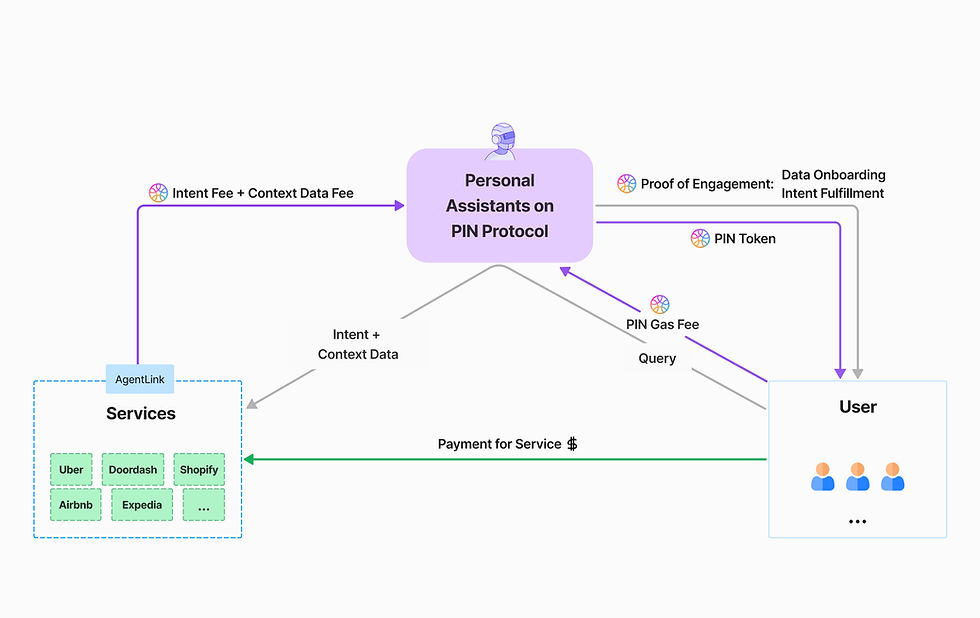Introducing PIN AI: The Open Platform for Personal AI
- Xi Wang

- Jan 8
- 7 min read
Updated: Feb 18
Davide Crapis, Bill Sun, Ben Wu, and Regan Peng — co-founders of PIN AI
We are building the Personal Intelligence Network (PIN) as a new platform for Personal AI with crypto-economic security that gives users privacy, ownership, and many new useful applications built on open source AI.
Over the past year, following the widespread adoption of ChatGPT and similar AI tools with impressive capabilities, there has been increased attention in the blockchain industry on how crypto primitives can be used with AI. The field of Crypto x AI was born. On the infrastructure side, there are many projects focused on providing services for decentralized compute, data availability/storage, and verifiable inference. On the application side, there are experiments with AI prediction markets, trading agents, and DAO bots. The vast majority of applications is focused on helping users understand and interact with web3 protocols, which is an important and growing but still limited use case.
At the same time, the AI industry is burgeoning. Living in the Bay Area, we have witnessed first hand the excitement and energy that building in AI generates. Many friends, excellent engineers and scientists, have left their full-time jobs to start AI projects. On the infrastructure side, there are successful projects that create new and needed services, such as vector databases, evaluation services, and model routing services. On the application side however, despite much hype, many well funded projects struggle to find market fit and wide adoption. The core problem is that AI applications need contextual data to provide useful inference and without this data it is impossible to provide a service that is more useful than the latest version of ChatGPT.
Moreover, Big AI Labs quickly incorporate the best innovations from open source builders, effectively killing or absorbing new projects as soon as they are born, and Big Tech Firms are trying to monopolize access to AI services.
We are building the PIN AI to take the opposite track: creating an open AI network with access to massive contextual data, where AI builders can create a wide range of useful AI applications. PIN is rooted in Open Source AI and Ethereum with three foundational layers: Personal Data (with focus on privacy and data ownership), Personal AI (useful and trustworthy companion AI on private devices), and External AIs (an open market of AI services).
A Platform for Useful AI Applications
Our goal is to enable AI developers to deliver useful AI services, such as purchasing groceries or other retail items, organizing their next trip, planning financial actions, etc. Today, these are not possible because External AIs such as ChatGPT lack the necessary user context, history, and preferences. Instead, our Personal AI has full context on its human owner, acts as its assistant and its mediator when summoning more powerful External AIs in the cloud to fulfill user intents, while always preserving user privacy. Our network enables the aforementioned services and many more. In the future Personal AIs will also be able to act in collaboration to achieve shared goals for their human owners.
In order to get there, Personal AIs need to be capable, have access to a wide range of owner data, and need to trust and pay External AIs when they outsource services to them. Interaction with personal data and External AIs determine the fundamental principles for our protocol design. A Personal AI lives on the user device, but the rich user context cannot entirely live on that device because of system constraints and the increasing amounts of personal data we generate. Personal AI will need to store personal data on secure storage, encrypted, and make it accessible on demand to External AIs.
The secure storage solution needs to guarantee: (1) privacy of personal data, and (2) data ownership and control to users. The most desirable solution for this is a decentralized storage with a data accessibility/availability gadget. Web2 cloud solutions are inferior on all dimensions: privacy guarantees depends on internal policies of providers and are not strong, provider owns user data, high frequency access to the data from AI users cannot be guaranteed because there are no inherent mechanisms to prevent Sybil and spam. Some centralization of service can be tolerated if paired with confidential compute (TEEs) and client-side encryption, which are solutions we are currently working on.
On the other hand, interactions between Personal AI and External AI, which may involve personal data exchange, also needs to hold similar properties. For example, no private user data is revealed to External AI, unless such External AI computation is private and we have guarantee that such External AI cannot “remember” the private data. The best way to guarantee privacy and fairness when outsourcing to External AI services is an auditable exchange, such as one implemented on a public blockchain, and not on servers of one private service provider such as Apple.
The main goal of the PIN Protocol is to enable an open ecosystem of Personal AI applications. We will focus on creating the infrastructure layer for getting access to user contextual data and matching user intents to specialized External AIs while always preserving user privacy. This also delivers the best allocative efficiency because historical performance of models can be monitored, evaluated, and AI MEV can be minimized.
PIN Protocol
The PIN protocol is the backbone of the open source ecosystem built around PIN AI. It provides trust minimized activity tracking and value exchange, access to valuable personal data, and an open innovation platform for new AI services. There are three key components of the protocol that we need to bootstrap the PIN economy.
Data Connectors and Onchain Registry: track and verify user data sources connected to the network. Use state of the art of zero knowledge cryptography (such as zkTLS) to verify data provenance and machine learning techniques to update real user data contributions in the registry at the end of each epoch.
Private Storage and Compute Layer: provide secure and private data storage beyond user own device capacity. Use a permanent storage solution with a data access gadget to store massive amounts of user data (including photos, videos, etc) and make the most relevant data readily available to personal AIs.
Agent Links and Intent Market: open up user intent fulfillment to AI agent applications. Build a permissionless agent registry and exchange mechanism, the registry keeps track of performance metrics while the exchange specifies how personal AI queries are matched to agents (on the bases of cost, performance, and quality of each agent). In order to bootstrap this component we are going to help developers to convert current Web2 applications (such as Amazon, DoorDash, Uber, etc) into agentic services, which we call Agent Links.
PIN AI
On the AI side, PIN AI introduces a sophisticated architecture designed to balance privacy, performance, and personalization through its Hybrid Models. These models combine on-device processing with cloud-based computation, ensuring that sensitive operations remain under user control while leveraging powerful cloud models for complex tasks. This hybrid approach allows the AI to continuously learn from the Personal Index, a dynamic knowledge graph that organizes user data from both on-device and cloud sources, providing contextually relevant and personalized responses.
Key to PIN AI's innovation is its focus on privacy and context management. The platform incorporates a BERT-based model specifically designed to detect and anonymize Personally Identifiable Information (PII) at various stages of data processing, maintaining confidentiality and compliance with data protection regulations. Additionally, the RAG (Retrieval-Augmented Generation) and GraphRAG models enhance the AI’s ability to retrieve relevant information and perform complex reasoning by leveraging structured knowledge graphs, ensuring that responses are context-rich and personalized to the user's needs.
In the future, PIN AI will enable Autonomous Workflows for fine-tuning. Personal AI models will be continuously fine-tuned, with on-device models adapting in real-time to user preferences, and cloud models aggregating anonymized data for broader capability enhancements. Leveraging unique personal data and user patterns PIN AI will push the frontier of AI personalization, delivering to each user a Personal AI that they truly owns and gets better and more personalized over time.
Bootstrapping the PIN Economy
PIN has at its core a two-sided market where user and their Personal AI access services from External AIs. The amount and value of services that can be provided increases with the amount of user contextual data made available to these services. The data connectors and the onchain registry are part of our proof-of-engagement protocol (PoE), which is designed to incentivize users to connect data and perform valuable transactions on the platform. There are two main components:
Data Connection Incentives: user gets an allocation for simply connecting their personal data on the network. Privacy is guaranteed by user-level encryption. Sybil resistance is achieved via a combination of cryptographically authenticated data provenance (zkTLS), machine learning technique to evaluate human digital trace, and digital identity (e.g., WorldID).
Proof of Valuable Transaction: user gets an allocation from the protocol when they complete provable valuable transactions with an Agent Link. The transaction needs to transfer economic value (in crypto or fiat) and be provable onchain (e.g., via zkTLS for fiat payments).
Ecosystem Participants, Incentives, and Economic Flows
There are three main participants in the PIN ecosystem: end users, data connectors, and agent services.
Users are incentivized to connect their personal data to the PIN network, while maintaining ownership and privacy, via data connectors. This allows the PIN network to accumulate rich context of user data that can be leveraged by agent services.
Data connectors are also incentivized initially, they are part of the infrastructure serving the PIN network and they can be operated by third parties. They are secured by a stake and slash mechanism and operators and stakers are rewarded.
The protocol will enable the creation of new agent services and make them easy to deploy via Agent Links. These agents will be able to leverage user contextual data to better serve user intents and provide useful services. Agent service operators will also be crypto-economically secured and incentivized.
In the future, user will want to pay to access valuable agent services, which in turn will pay the protocol for accessing personal data and user intents, via a dynamic fee determined by a market mechanism with supply and demand.

Figure: Transaction value flows in PIN.
Conclusion
The vision for PIN AI is ambitious, requiring the collective efforts of a vibrant community of users and builders to bring it to life. With an outstanding core team and secured funding, we are well-positioned to embark on this transformative journey. As we prepare for the imminent launch of our AI application and the upcoming testnet for the PIN AI protocol, we are excited to invite the community to join us in shaping the future of personalized, privacy-focused AI. Together, we can realize the full potential of this groundbreaking platform and deliver Personal AI that are fully owned by and empower their users.




Comments